Exploring Underwater Surfboards: A New Watersport
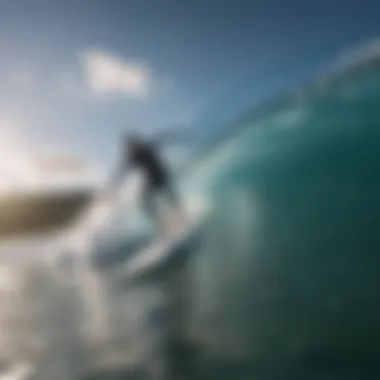

Intro
Diving into the depths of innovation, underwater surfboards offer a fresh line of approach in the world of watersports. Envision gliding beneath the waves, feeling each undulation of the ocean as you navigate through a realm once reserved for fish and other sea creatures. This shift from traditional surface riding to the underwater experience is not just a passing fad; it signifies a deeper connection with the aquatic environment and the pursuit of adventure.
Often overshadowed by more conventional surfing, the underwater surfboard is gaining traction in niche surfing communities and among thrill-seekers alike. Designed to function effectively beneath the surface, these boards push the boundaries of how we perceive surfing. But what does it take to dive headfirst into this exhilarating sport? Let's explore the essential gear and techniques that will prepare both newcomers and seasoned surfers for their underwater adventures.
Gear Recommendations
Having the right gear is crucial for an optimal underwater surfing experience. With technology advancing at an impressive rate, the choices available now extend beyond what you would typically expect in the world of traditional surfing.
Essential Gear for Beginners
Before taking the plunge, novices should focus on acquiring equipment tailored to ease them into the sport. Consider the following essentials:
- Underwater Surfboard: Select one that’s lightweight and buoyant. Many cater to beginners, featuring a user-friendly design.
- Wetsuit: A proper wetsuit keeps you warm and helps with buoyancy. Opt for one that fits snugly but allows for easy movement.
- Snorkel and Mask: A good-quality snorkeling setup lets you breathe comfortably while observing the underwater world. Look for a mask that provides a wide field of vision.
Advanced Equipment for Professionals
For seasoned surfers looking to take their skills to the underwater domain, not just any gear will do. Here’s a quick rundown on what to consider:
- High-Performance Boards: Lightweight carbon-fiber boards allow for better maneuverability, crucial for advanced techniques.
- Fins and Blades: Explore specialized fins designed for stability and control.
- Dive Watch: A reliable dive watch helps keep track of depth and time, critical for ensuring safety.
Techniques and Tips
Mastering any skill requires practice, but it’s essential to approach underwater surfing with an awareness of unique techniques and safety measures.
Skill Improvement Strategies
Improving your underwater surfing skills isn’t just about time spent in the water; it also requires strategic training. Focus on:
- Breath Control: Utilize training exercises to extend your breath-holding capacity.
- Hydrodynamic Positioning: Learn the optimal body position for gliding through water to reduce drag and facilitate speed.
- Adaptability: Be prepared for changes in the water’s current or temperature by practicing in varied conditions.
Safety Practices and Guidelines
Safety should be your top priority. Follow these guidelines:
- Always surf with a buddy. This is a fundamental rule in any aquatic activity.
- Monitor weather conditions; storms can change the dynamics of the water.
- Familiarize yourself with basic underwater signals to communicate with your partner.
"Underwater surfing is an adventure that requires both skill and respect for the ocean. Knowing your limits is just as crucial as pushing them."
As you gear up, whether you are a novice or a professional, the underwater surfboard represents more than just a new piece of equipment. It embodies a shift in how we experience and interact with an endlessly fascinating medium. The thrill of riding waves below the surface beckons; dive in and discover your new favorite watersport.
Prelims to Underwater Surfboards
The world of watersports is no stranger to innovation, and the concept of underwater surfboards is perhaps one of the most intriguing developments in recent times. In this section, we'll explore the vital aspects surrounding underwater surfboards, examining what makes this new approach so captivating and beneficial for a wide range of users, from seasoned athletes to curious hobbyists.
For many, surfing is synonymous with thrilling waves, salty air, and a sense of freedom found on the ocean's surface. However, with underwater surfboarding, enthusiasts now have the chance to delve deeper, quite literally, into the aquatic environment. This new facet of surfing not only expands one's experience of the ocean but also introduces unique challenges and techniques that truly test an adventurer’s skills and adaptability.
The Genesis of Underwater Surfboarding
The idea of surfing beneath the waves seems futuristic, yet it has roots that can be traced back to ancient cultures that utilized marine elements for leisure and transportation. The emergence of modern underwater surfboards can be seen as a confluence of technological advancements and a desire to explore new territories in sports. Creators and enthusiasts alike sought to devise a way to ride the current while remaining submerged.

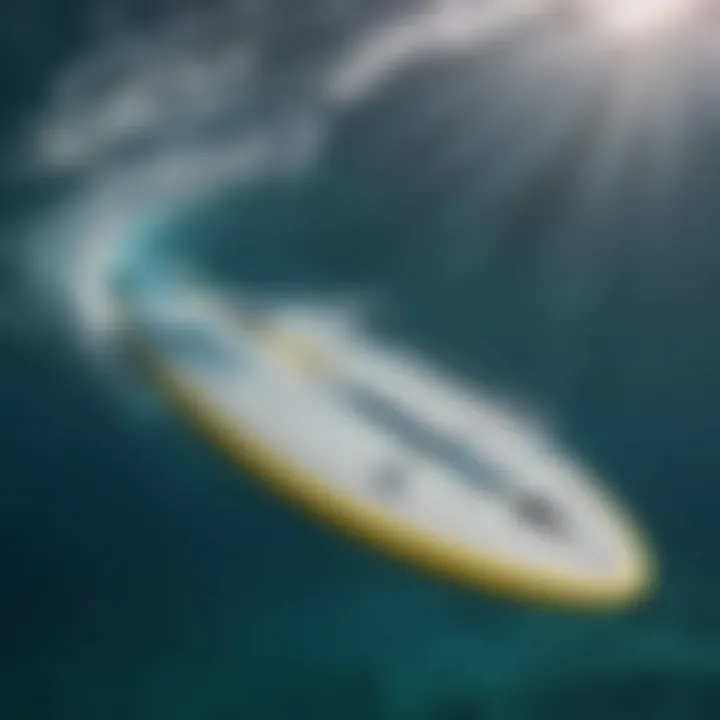
From the inception of diving technologies to today's sophisticated hydrofoils, the journey has been substantial. In recent years, innovative materials and designs have cropped up, facilitating a smoother and safer diving experience. Surfers and divers are increasingly combining their passions, leading to the birth of this enthralling practice.
Defining Features of Underwater Surfboards
Underwater surfboards come packed with distinct features that set them apart from traditional boards. Here are some noteworthy characteristics that define these boards:
- Hydrodynamic Design: The shape and contours are engineered to minimize drag, allowing for a smoother glide underwater. Surfboards can vary in width, length, and overall profile to accommodate different surfing styles.
- Material Composition: Many underwater surfboards utilize lightweight composites that provide both flexibility and durability. Materials such as carbon fiber or specialized foams serve to enhance buoyancy and stability in the water.
- Fins and Stabilizers: Equipped with fins, much like conventional surfboards, underwater boards often have additional stabilizers that improve maneuverability while controlling depth.
- Buoyancy Features: Some boards are designed with enhanced buoyancy mechanisms, facilitating easier buoying up to the surface when the rider is ready to emerge from the water.
- Streamlined Controls: Many boards integrate streamlined handles or grips that allow surfers to maintain control while navigating through aquatic terrains.
"Underwater surfboards offer a unique thrill, enabling surfers to tap into the ocean’s rhythm in a wholly new way, while also pushing the boundaries of traditional surfing."
In summary, underwater surfboards represent a pioneering leap into the depths of aquatic fun. They not only challenge the familiar surfing paradigm, but they also promote creativity and skill development among watersport enthusiasts. As we delve further into the article, we will compare intricate surfing techniques and discuss safety considerations, ensuring a well-rounded perspective on this exciting new sport.
Design Innovations in Underwater Surfboards
The emergence of underwater surfboards signifies a substantial leap in surfboard design, rooted deeply in both functionality and aesthetics. This evolution is not just about creating an alternative to traditional surfing; it’s about redefining the experience aquatic sports enthusiasts value. Notably, the innovations in design take into account both the needs of surfers and the dynamic challenges presented by underwater environments. By blending cutting-edge technologies with thoughtful design, manufacturers aim to craft boards that promise enhanced performance and safety.
Material Choices and Their Significance
The choice of materials plays a critical role in the design of underwater surfboards. Imagine a blend of lightweight yet strong compounds that can withstand the rigors of the ocean’s depths while allowing the surfer to achieve superb control and agility. While traditional surfboards often utilize foam and fiberglass, underwater boards often incorporate advanced materials such as carbon fiber and specialized polymers.
- Carbon Fiber: Known for its impressive strength-to-weight ratio, carbon fiber provides durability. This material ensures that the board can handle collisions with marine debris, underwater currents, or rocky surfaces without compromising its integrity.
- High-Density Polyethylene: This material offers buoyancy and resistance to impact. Moreover, it is less susceptible to water absorption, prolonging the lifespan of the board.
- Composite Foams: Many designs now use composite materials that not only enhance flotation but also improve the board’s overall hydrodynamic performance, leading towards smoother rides.
When these materials interact, they create a board that is not just designed to perform but also easy to maneuver. The integration of these advanced materials reflects a profound understanding of the physics at play, promoting an unparalleled surfing experience below the water’s surface.
Hydrodynamics: The Science Behind Performance
Understanding hydrodynamics is crucial for optimizing performance in underwater surfboards. This branch of physics delves into how water interacts with solid objects, influencing everything from speed to stability. In the context of underwater surfboarding, the design incorporates various elements inspired by marine biology and engineering.
- Hydrofoils: Some modern surfboards come equipped with hydrofoil technology, which allows the board to lift above the water’s surface when enough speed is achieved. This innovative design significantly reduces drag, resulting in smoother rides and enhancing maneuverability.
- Streamlined Shapes: The shape of an underwater surfboard is not merely aesthetic; it influences how water flows around the board. Sharper edges and tapered tail sections allow for more precise turns and faster navigation through currents.
- Weight Distribution: Balancing the weight of the board is essential for performance. Designers significantly focus on centering the mass to keep the board stable during underwater maneuvers, allowing surfers to maintain control even in turbulent conditions. This balance enhances responsiveness, giving surfers an edge while carving through the aquatic landscape.
Hydrodynamics can make or break a surfing experience; understanding it leads to boards that not only survive but thrive beneath the waves.
In essence, the design innovations present in underwater surfboards embody a melding of material science and hydrodynamic understanding, resulting in boards that bridge the gap between performance and adventure. For those who dare to embrace this new medium, the thrill lies in the seamless integration of these enhancements, paving the way for a fresh frontier in the realm of watersports.
Comparative Analysis of Surfing Techniques
Understanding the comparative analysis of surfing techniques offers crucial insights into how both surface riding and underwater surfing operate. As we explore these diverse modalities, it is important to recognize their unique complexities and advantages. Just as a painter needs to know the difference between oil and watercolor, so does a surfer need to grasp the distinctions between these two realms of surfing. This comparison not only highlights the technical variations but also enriches the overall experience of watersports enthusiasts.
Surface vs. Underwater Dynamics
When it comes to surface surfboarding, riders utilize gravity and the wave’s momentum to perform tricks and maneuvers. The sensation of riding on the surface is often exhilarating, as one rides the crest of waves, feeling the rush of wind and sea spray. The dynamic involves continuous adjustment to maintain balance while gaining speed and power from the waves. In contrast, underwater dynamics introduces an entirely different feel.
When submerged, surfers experience a cooling embrace as they glide through the water. Here, speed is not achieved through the wave's elevation but rather through streamlined movement and proper angling. The underwater surfboard design allows for easier navigation and faster propulsion, harnessing the push of the current rather than relying solely on the wave energy. This shift alters not only the techniques used but also the cognitive approach to surfing—adaptability becomes paramount.
Many enthusiasts find underwater surfing's unique environment offers a sense of tranquility that can be quite rare in surface surfing. The marine life and reefs add an engaging element, creating a mesmerizing ballet between surfer and nature.
"Underwater surfboarding redefines what it means to ride the waves, blending the thrill of speed with a serene connection to the ocean's depths."
Adapting Techniques for Underwater Maneuvering
To successfully transition between surface and underwater techniques, surfers must adapt their physical and mental approach. Techniques that work well above sea level can become cumbersome or ineffective below water. Here are some essential adaptations:
- Body Positioning: Underwater requires a more streamlined posture. Surfers should keep their bodies horizontal and engage the core to facilitate efficient movement. This stance is crucial to reducing drag.
- Breath Control: Unlike traditional surfing, where you may have the luxury of catching your breath at intervals, underwater surfing necessitates focus on breath control. Developing the ability to hold breath and manage oxygen intake will determine one’s stamina.
- Maneuver Techniques: Movements like turning or carving need to be executed with precision. The fluid resistance means all actions must be deliberate, using fin placement and body weight effectively.

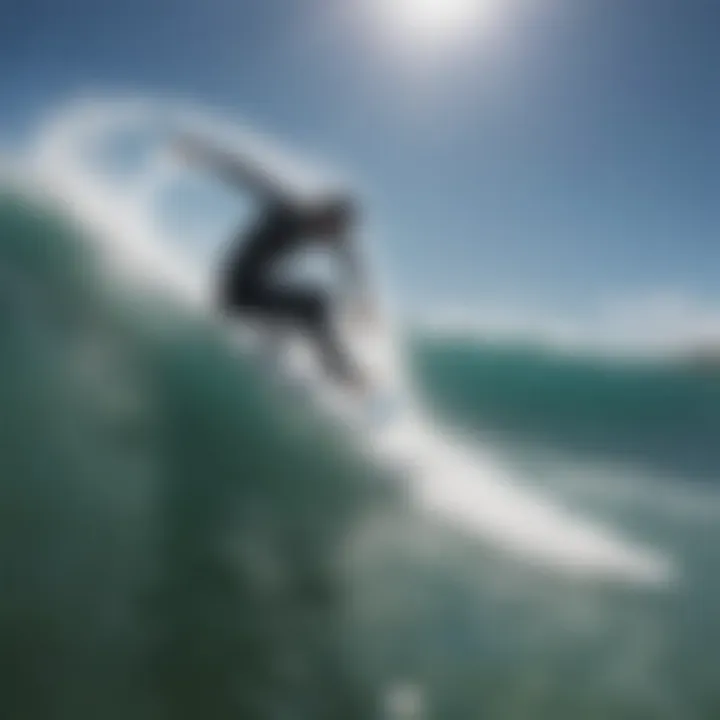
Adopting these tailored techniques is a journey unto itself. It's not just about practicing movements; it’s about understanding the water as an ally rather than a barrier.
As surfers delve into the intriguing world of underwater surfboards, they discover not only an exciting sport but also a deeper appreciation for their aquatic surroundings. The nuances of technique become part of the adventure, paving the way for further exploration in this breathtaking dimension of watersports.
Safety Considerations in Underwater Surfboarding
Safety is paramount in any kind of sport, and underwater surfboarding is no exception. Engaging in this exhilarating activity demands a keen awareness of the potentials risks involved and a proactive approach to ensure the safety of participants. The uniqueness of navigating beneath the surface introduces various elements not typically encountered in traditional surfing. While it offers an entirely new perspective and perhaps a more serene experience, the safety considerations cannot be overlooked. Whether you are a seasoned pro or just dipping your toes into the new depths of this sport, understanding safety is crucial for enjoyment and confidence in the water.
Understanding Risks and Precautions
Diving beneath the waves can expose surfers to different sets of risks. Here are a few key aspects to keep in mind:
- Drowning Hazards: Underwater activities inherently carry a risk of drowning. Surfers must be proficient swimmers. Familiarity with free diving techniques can be invaluable as it teaches breathing control and efficient movement in water.
- Environmental Considerations: Underwater visibility varies greatly. Murky waters can make navigation challenging. Always be aware of your surroundings and assess water clarity before heading out.
- Wildlife Encounters: The underwater world is home to a multitude of creatures. While most are harmless, it is wise to know which species to watch for. Encounters with jellyfish, rayfish, or even sharks require knowledge and respect.
- Surfboard Control: When submerged, maintaining control of your surfboard is vital. High-speed movements without awareness can lead to accidents. Keep a physical grip on your board when not riding it.
Several precautions can mitigate these risks, including:
- Buddy System: Always surf with a partner. This ensures someone is there to help in case of emergency.
- Pre-Surf Briefings: Before hitting the water, discuss safety protocols with your surf buddy. Agreement on signals and boundaries can make activities much safer.
- Training: Enroll in surfboard safety classes or free diving courses to build skills. Knowing how to handle situations can make all the difference.
"Preparation is the key to safety in water sports. The more you know, the less likely you are to end up in a precarious situation."
Safety Gear Recommendations
Just like every sport has its equipment, underwater surfboarding has its share of safety gear designed to keep surfers protected. Some essentials include:
- Wetsuit: Provides thermal protection and buoyancy. A good wetsuit can be your best friend when the waters get chilly.
- Surfboard Leashes: A well-fitted leash secures the board to the surfer. This not only keeps the board close during rides but also mitigates the risk of injury to others.
- Low-Profile Dive Mask: A dive mask greatly enhances underwater visibility and comfort. Choose one that fits snugly to prevent leaks.
- Fins: Specialized fins can help in maneuverability underwater, helping to propel and steer effectively.
- Diving Knife: In an emergency, a diving knife can be a lifesaver if entangled in underwater vegetation or equipment.
Experiencing Underwater Surfing
Experiencing underwater surfing is more than just a novel twist on an old pastime. It reshapes our understanding of aquatic sports. The thrill of gliding beneath the waves offers a different perspective on oceanic freedom. For those looking to elevate their surfing game, it presents unique opportunities and challenges. With the right approach, enthusiasts can discover new depths, literally and figuratively.
Preparedness and Skills to Cultivate
Stepping into the world of underwater surfing requires a blend of preparations and techniques that differ from typical surfing. The following elements are vital for anyone wishing to dive in:
- Buoyancy Control: Mastering buoyancy plays a key role. This means understanding how to adjust your body position and gear to maintain control underneath the water.
- Breath-Holding Techniques: Although this may sound elementary, the ability to hold your breath for extended durations is crucial. Practicing techniques like diaphragmatic breathing can enhance this skill significantly.
- Hydrodynamic Awareness: Knowing how to maneuver with currents and undersea obstacles can make or break one's experience. Training under various water conditions is beneficial.
- Equipment Familiarity: Understanding how your surfboard operates underwater, its buoyancy, and drag characteristics will elevate your performance. Each model has unique features—it’s important to be acquainted with your own gear.
- Physical Conditioning: Staying fit isn’t just a cliché; it's vital for endurance. Swimming, strength training, and flexibility exercises help in building a solid foundation for underwater activities.
These skills translate not only into heightened enjoyment but also into the ability to react quickly to changing conditions under the water.
Typical Settings for Underwater Surfing
Selecting the right environment for underwater surfing is just as critical as the gear you choose.
- Reef Breaks: Tropical locations with vibrant coral reefs can provide stunning visuals while you ride underwater. The colorful marine life adds another layer of excitement.
- Waves with Depth: Areas where waves are consistently sizable and deep offer the chance to ride powerful swells. Such locations often attract both surfers and divers alike.
- Calm Coastal Lagoons: Perfect for beginners, these spots provide a serene atmosphere for practicing fundamental skills in a less chaotic setting.
- River Mouths: These unique spots often combine both river and ocean waves, creating a thrilling mix of conditions that can be enjoyed underwater.
"There's nothing like the serenity of being under the surface, feeling the energy of the water without the chaos above."
In each of these settings, one can encounter different challenges, from navigating currents to responding to sudden shifts in tide. This variability is part of what makes underwater surfing both exhilarating and a touch unpredictable.
Exploring the nuances of underwater surfing is an enriching experience. By actively engaging with the preparatory steps and understanding the potential environments in which to practice, enthusiasts can truly immerse themselves in this innovative sporting approach.
Community and Culture Surrounding Underwater Surfboarding
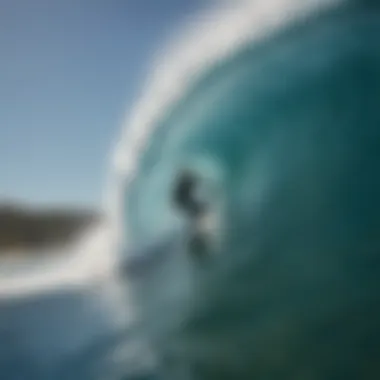
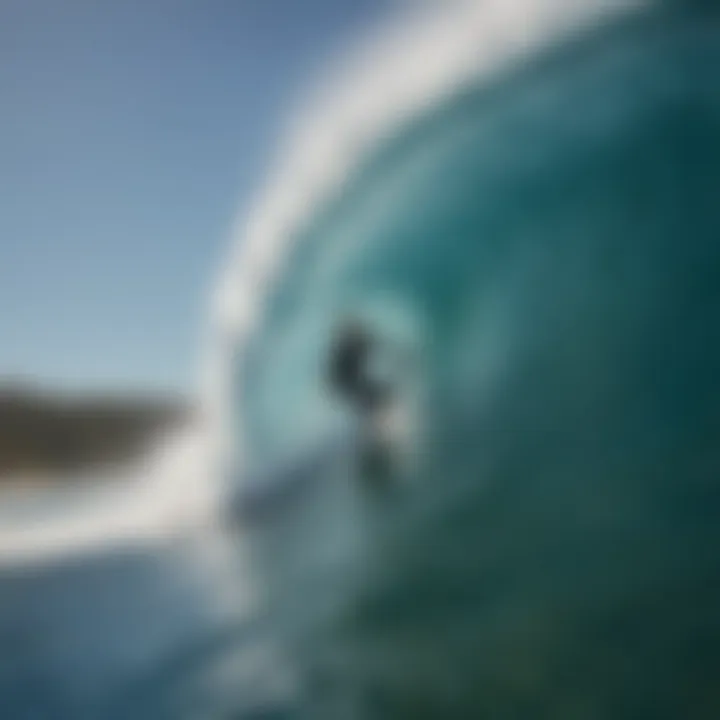
The phenomenon of underwater surfboards has not only carved out a niche in the world of watersports, but it's also fostered a unique community that celebrates the joys of aquatic exploration. This section delves into what holds this community together and how cultural changes have paves the way for broader acceptance and enthusiasm for underwater surfboarding.
The Growing Community of Enthusiasts
Underwater surfboarding, while a relatively new sport, is rapidly gaining traction among those who seek adventure beneath the waves. Enthusiasts are forming clubs and societies dedicated to sharing experiences, tips, and tricks of the trade. These gatherings provide a platform for participants to showcase their skills and innovations.
- Social Media Influence: Platforms like Facebook and Reddit have become vibrant hubs for enthusiasts. Groups specifically centered around underwater surfboarding share videos, stories, and advice, creating a sense of camaraderie. This digital interaction helps forge connections that span across the globe, making it easier for novices to learn from seasoned riders.
- Local Meetups and Events: In addition to online discussions, local meetup events are springing up in coastal areas where the ocean offers the perfect playground. These meetups encourage individuals to come together, test new gear, and hone their techniques in a supportive environment. Many onlookers become curious and often join in, expanding the community even further.
Cultural Shifts and Acceptance
As underwater surfboarding gains validity, perceptible cultural shifts surface. The long-held notion that surfing is solely a surface sport is being replaced by a more inclusive understanding of aquatic sports. This acceptance is essential in pushing the boundaries of what's possible in the water.
- Rethinking Watersports: Traditional surfers may have had reservations about underwater surfboarding, viewing it as an offshoot rather than a legitimate facet of surfing itself. However, as more participants showcase their talent, even skeptics are beginning to embrace the enthusiasm and passion of the underwater surfing community.
- Diversity in Participation: The accessibility of underwater surfboarding appeals to a broader demographic, including individuals who may find traditional surfing daunting. It breaks down barriers that once kept people from experiencing the joys of watersports—some may even find underwater riding to be a more graceful and exhilarating way to engage with the ocean.
"Underwater surfboarding is not just a new trend; it's a way of reimagining the ocean and our relationship with it."
The Future of Underwater Surfing
The future of underwater surfing stands as an exciting prospect poised to redefine the watersports landscape. This emerging discipline is at the intersection of adventure and technology, capturing the attention of outdoor enthusiasts, athletes, and instructors alike. Key to understanding this future is recognizing specific elements such as technological advancements, growing community interest, and evolving market dynamics that promise to enhance accessibility for many. As we navigate these waters, several benefits and considerations come to light that merit a closer examination.
Technological Advancements on the Horizon
Underwater surfboards rely heavily on technology, and the advancements in this area are nothing short of revolutionary. From enhanced materials giving boards increased buoyancy to waterproof electronics that allow for real-time performance tracking, innovation is fueling this underwater endeavor.
Expected advancements could include:
- Lightweight Materials: Future boards may incorporate carbon fiber or other advanced composites to minimize weight while maximizing strength.
- Integrated Sensors: These could provide data on underwater currents, water temperature, and diving depths, enriching the surfing experience.
- Smart Technology: Imagine surfboards equipped with GPS and communication gadgets to enhance safety, allowing users to connect with companions or signal for help if needed.
This infusion of technology aims to improve performance and enable surfers to explore previously inaccessible areas while ensuring safety.
Predictions for Market Growth and Adoption
With the increasing popularity of underwater surfing, industry analysts foresee a significant surge in both market growth and wider adoption among diverse groups. Factors contributing to this optimistic outlook include:
- Growing Interest: As watersports enthusiasts look for novel experiences, underwater surfing offers a fresh perspective on both surfing and the aquatic environment.
- Improved Accessibility: The blending of technology with design paves the way for boards that cater to varying skill levels, encouraging more hobbyists to dive in, so to speak.
- Environmental Awareness: Surfers often have a profound connection with the ocean. With rising awareness around environmental issues, underwater surfing may also evolve into a platform for marine conservation education and eco-friendly practices.
The fusion of thrill-seeking and technology positions underwater surfing at the forefront of watersport evolution, attracting a diverse demographic eager to ride this wave.
Finale
As we reach the end of our exploration into underwater surfboards, it's crucial to reflect on the significance of this innovative modality within the realm of watersports. These surfboards are not just a gimmick; they represent a shift in how enthusiasts engage with the water and experience the thrills of surfing. The underwater surfboard blends the grace of aquatic movement with the challenge of mastering a new skill set, inviting surfers to redefine their connection with the ocean.
Summarizing the Impact of Underwater Surfboards
Underwater surfboards have introduced a novel way of interacting with aquatic environments. This approach to surfing encourages a deeper appreciation for marine ecosystems, as divers can truly immerse themselves in this underwater world without the traditional barricades of air and surface sports.
While the traditional surfboard allows for measuring skills above water, underwater surfboards demand a different kind of finesse. They require an adept understanding of hydrodynamics, buoyancy, and optimal body positioning which adds layers to the surfing experience. Surfers are learning to navigate not just the waves but also the currents and marine life that exist below the surface.
The impact is felt not only on individual surfers as they hone their skills but also on the community at large. It creates a shared culture centered around curiosity, exploration, and respect for the ocean. Enthusiasts gather to share tips, techniques, and stories, deepening their bonds through a shared passion. As such, underwater surfing is forging connections that transcend borders, enhancing camaraderie among diverse groups.
Call to Exploration and Community Engagement
Engaging with underwater surfboards is an invitation to adventure. It's about more than just catching waves—it's a journey of discovery that encompasses the beauty of our oceans. For current surfers and newcomers alike, stepping into this realm opens doors to unique experiences; from observing marine life closely to taking part in a community that is enthusiastic about conserving the ocean.
Interest in underwater surfboarding is on the rise, and anyone with a sense of adventure should consider trying it out. Local clubs, online communities, and social media groups abound—these are invaluable resources for beginners looking to learn from seasoned pros. Joining forums on platforms like Reddit or engaging in discussions on Facebook can help pave the way for learning and networking.
As technology evolves, the underwater surfboard will continue to develop. Better materials, enhanced designs, and innovative safety features will likely emerge, making underwater surfing even more accessible. It’s essential for enthusiasts to stay connected and involved, ensuring that they share experiences and innovations within the community.
Ultimately, the underwater surfing experience is one that promises personal growth, connection with nature, and community solidarity. The allure of exploring the depths of the ocean awaits—and with it, a treasure trove of memories waiting to be made.















